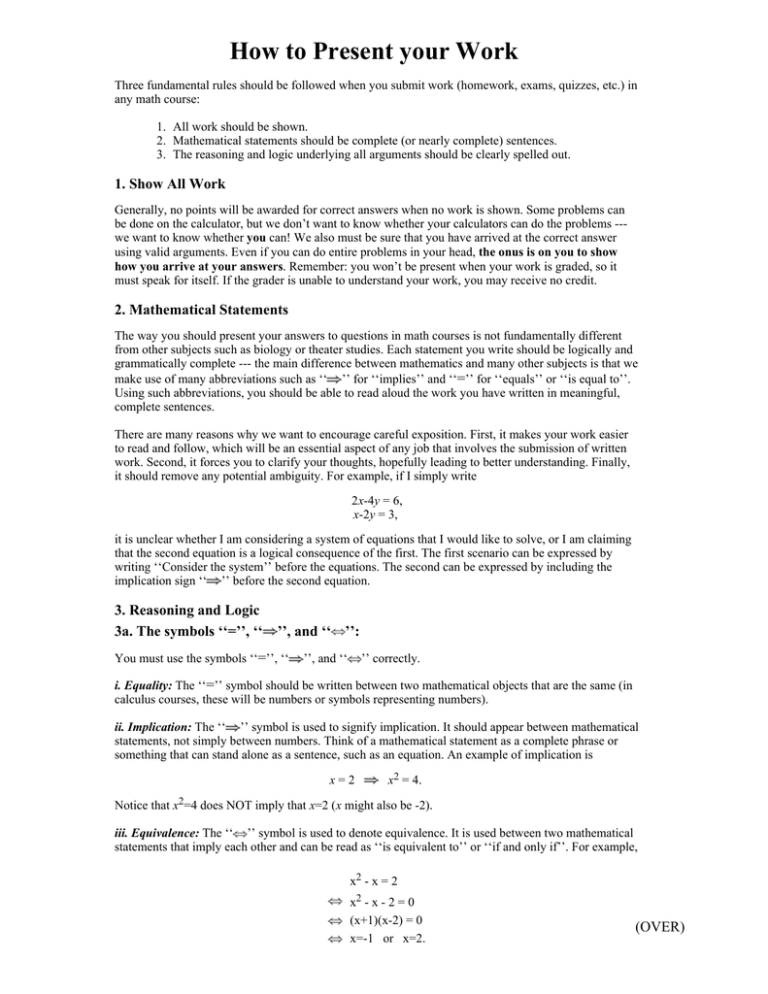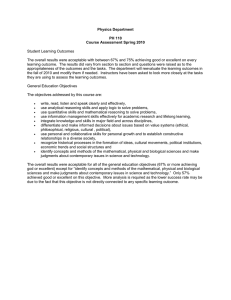How to Present your Work
advertisement

How to Present your Work Three fundamental rules should be followed when you submit work (homework, exams, quizzes, etc.) in any math course: 1. All work should be shown. 2. Mathematical statements should be complete (or nearly complete) sentences. 3. The reasoning and logic underlying all arguments should be clearly spelled out. 1. Show All Work Generally, no points will be awarded for correct answers when no work is shown. Some problems can be done on the calculator, but we don’t want to know whether your calculators can do the problems --we want to know whether you can! We also must be sure that you have arrived at the correct answer using valid arguments. Even if you can do entire problems in your head, the onus is on you to show how you arrive at your answers. Remember: you won’t be present when your work is graded, so it must speak for itself. If the grader is unable to understand your work, you may receive no credit. 2. Mathematical Statements The way you should present your answers to questions in math courses is not fundamentally different from other subjects such as biology or theater studies. Each statement you write should be logically and grammatically complete --- the main difference between mathematics and many other subjects is that we make use of many abbreviations such as ‘‘ ’’ for ‘‘implies’’ and ‘‘=’’ for ‘‘equals’’ or ‘‘is equal to’’. Using such abbreviations, you should be able to read aloud the work you have written in meaningful, complete sentences. There are many reasons why we want to encourage careful exposition. First, it makes your work easier to read and follow, which will be an essential aspect of any job that involves the submission of written work. Second, it forces you to clarify your thoughts, hopefully leading to better understanding. Finally, it should remove any potential ambiguity. For example, if I simply write 2x-4y = 6, x-2y = 3, it is unclear whether I am considering a system of equations that I would like to solve, or I am claiming that the second equation is a logical consequence of the first. The first scenario can be expressed by writing ‘‘Consider the system’’ before the equations. The second can be expressed by including the implication sign ‘‘ ’’ before the second equation. 3. Reasoning and Logic 3a. The symbols ‘‘=’’, ‘‘ ’’, and ‘‘ ’’: You must use the symbols ‘‘=’’, ‘‘ ’’, and ‘‘ ’’ correctly. i. Equality: The ‘‘=’’ symbol should be written between two mathematical objects that are the same (in calculus courses, these will be numbers or symbols representing numbers). ii. Implication: The ‘‘ ’’ symbol is used to signify implication. It should appear between mathematical statements, not simply between numbers. Think of a mathematical statement as a complete phrase or something that can stand alone as a sentence, such as an equation. An example of implication is x=2 x2 = 4. Notice that x2=4 does NOT imply that x=2 (x might also be -2). iii. Equivalence: The ‘‘ ’’ symbol is used to denote equivalence. It is used between two mathematical statements that imply each other and can be read as ‘‘is equivalent to’’ or ‘‘if and only if’’. For example, x2 - x = 2 x2 - x - 2 = 0 (x+1)(x-2) = 0 x=-1 or x=2. (OVER) (continued) 3b. Proofs: Some math classes require proofs. When you must present a proof, never assume what you are trying to prove. A common mistake is to make a mathematical statement, deduce something true from it, and then claim to have proved the original statement. THIS REASONING IS INVALID! Consider the following ‘‘proof’’ that -1=1: -1 = 1, (WRONG!) (-1)2 = 12, 1 = 1. The final statement (1=1) is clearly true. The use of the ‘‘ have proved is that ’’ sign, however, makes it clear that all we IF -1=1, THEN 1=1 We have NOT shown that SINCE 1=1, THEN -1=1 EXAMPLES OF PRESENTING WORK 1. Differentiate f (x)=x3. Good: f (x) = x3 f ’(x) = 3x2. Bad: f (x) = x3 = f ’(x) = 3x2. 2. Solve x+1/x=2. Note that x=0 is not a solution, so we can multiply both sides of the equation by x: 3. Simplify .







